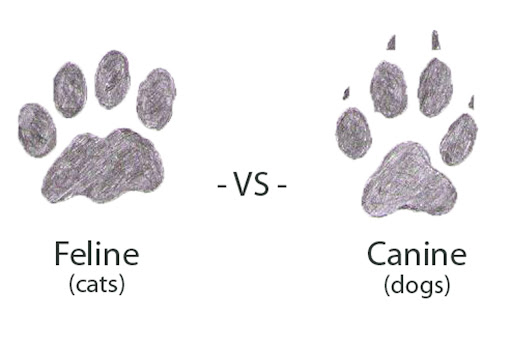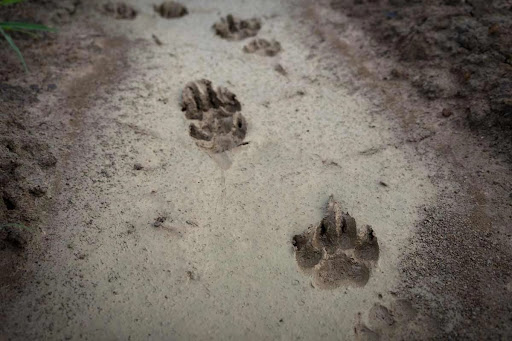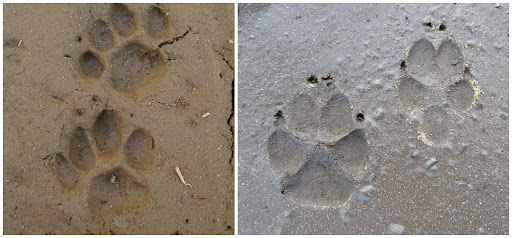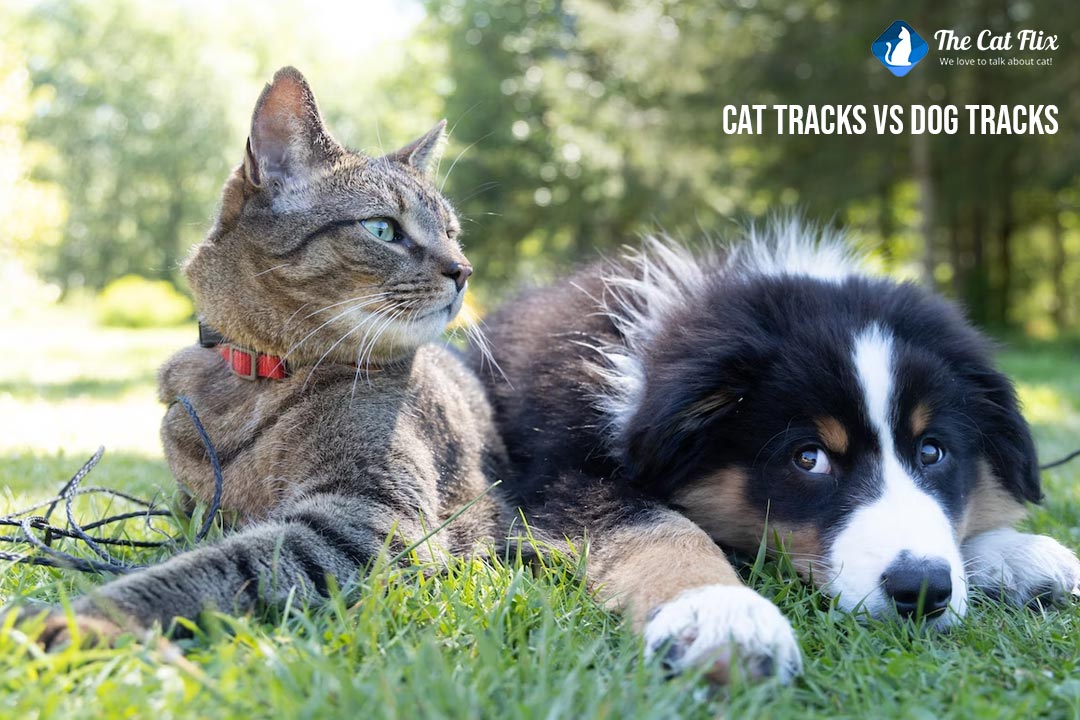Imagine you are walking in a forest, enjoying the fresh air and the sounds of nature. As you move forward, your eyes lock onto a trail of paw prints etched into the ground. You can’t help but wonder, “Did a cat or a dog pass through here?

How can I possibly tell?” In this article, we will show you how to identify Cat Tracks Vs. Dog Tracks with some simple tips and tricks. You will be amazed by how much you can learn from these clues!
What is Animal Tracks
Animal tracks are imprints left behind in soil, snow, mud, or some other ground surface by an animal walking across it.
Animal footprints may be used to determine the kind of animal that left them, as well as the direction, speed, and stride of the animal.

Tracks can also provide clues about the habitat, speed, behavior, and health of the animals. They are a valuable tool for naturalists and hunters alike.
Naturalists can use animal tracks to study the behavior and distribution of wildlife populations. Hunters can use animal tracks to track their prey.
What is the Difference Between Dog Prints and Cat Prints
Cat vs. Dog – the most common debatable topic in the whole world. But let’s leave their personalities aside for a moment and delve into their tracks, the unique imprints they leave behind.
So, what is the difference between dog and cat footprints? Cat Tracks Vs. Dog Tracks are two of the most common animal tracks found in urban and suburban areas.
While both animals have four toes on each foot, there are a few key differences between their paw prints like shape, size, claw marks and more.

Do Cats and Dogs Have a Unique Paw Print?
Yes, dogs and cats have unique paw prints. The main difference between cat and dog paw prints is the presence of claws. Another difference between cat and dog paw prints is the shape of the heel pad.
The heel pad is the large pad at the back of the foot. Finally, the number of lobes on the heel pad can also help to distinguish between cat and dog paw prints.
Are Domestic Cat Tracks and Wildcat Tracks Different?
There are some minor differences between domestic cat tracks and wildcat tracks.For example, wildcat tracks are typically larger than domestic cat tracks.
Additionally, wildcat tracks may show more signs of wear and tear, as wildcats spend more time outdoors and in rougher terrain.
However, the overall structure of domestic cat tracks and wildcat tracks is very similar. The main way to distinguish between Cat Tracks Vs. Dog Tracks is by the size of the track and the presence of signs of wear and tear.
How Can You Tell the Difference Between a Cat and a Dog Track
So, how can you tell apart between a cat and a dog track? Here are 6 ways to help you:
1. Size and shape
One of the most obvious distinctions is the size and shape of the tracks.
Cat:
- Smaller in size, typically ranging from 1 to 2 inches in length.
- More rounded in shape, with a less pronounced heel pad.
- The toes are more closely spaced together than in dog tracks.
Dog:
- Larger in size, typically ranging from 2 to 4 inches in length.
- More oval-shaped, with a more pronounced heel pad.
- The toes are more spread out than in cat tracks.
2. Paw pads
Paw pads are the soft, fleshy pads on the bottom of an animal’s paw. They have a thick coating of skin, fat, and connective tissue covering them.
Cat:
- Compact, with a distinctive three-lobed heel pad.
- The lobes are evenly spaced and roughly the same size.
- The toes are also compact and have small, rounded pads.
Dog:
- More spread out in size, with a single lobe on the heel pad.
- The heel pad is typically larger than the toe pads.
- The toe pads are also more spread out and have more pronounced claws.
3. Toenail marks
Toenail marks are the impressions left by the animal’s toenail in the substrate they are walking on.
Cat:
- Rare to see, as cats have retractable claws.
- If toenail marks are present, they are typically faint and shallow.
Dog:
- Almost always visible, unless the dog has recently had its nails trimmed.
- Typically sharp and well-defined.
4. Negative space
Negative space refers to the area between the toes and the heel pad.
Cat:
- C-shaped.
- The negative space is typically wider at the heel pad and narrower at the toes.
Dog:
- X-shaped.
- The negative space is typically more symmetrical and evenly distributed.
5. Symmetry of paw print
Track symmetry refers to how evenly balanced the paw print is.
Cat:
- Generally less symmetrical or asymmetrical than dog paw prints.
- The left and right sides of the track are not mirror images of each other.
- Cats walk with their front feet slightly offset from their back feet.
- This is because cats have more flexible paws and can walk in a variety of gaits
Dog:
- Mostly more symmetrical than cat paw prints.
- This is because dogs have a more rigid gait.
- Dogs walk with their front feet aligned with their back feet.
- The toes are typically the same length and the negative space is usually evenly distributed.
6. Gait and Stride
Cats and dogs have different gaits and strides, which can also be helpful in distinguishing between their tracks.
Cat:
- Direct gait, with all four paws moving in a straight line
- Longer stride
Dog:
- Diagonal gait, with the front paws moving in a different pattern than the back paws
- Shorter stride
What are the Factors Can Affect the Track Appearance?
While understanding the basics of animal tracks is essential, it’s equally crucial to recognize that various factors can influence the appearance of tracks.
Action
The kind of action taken by the animal can affect the appearance of its traces, such as walking, running, jumping, or resting, and can affect the shape, size, and spacing of the tracks.
For example, a cat running will have more widely spaced tracks than a cat walking. A dog chasing a squirrel will have more pronounced toenail marks than a dog walking on a leash.
Speed
The animal’s movement pace may also affect the look of its tracks. A faster animal may leave more blurred and distorted tracks than a slower animal.
On the other hand, a slower animal may leave more clear and detailed tracks than a faster animal.
A fast-moving animal may also have less defined paw pad impressions, as the pads do not have as much time to make contact with the ground.
Substrate
The substrate is the surface on which the animal leaves its tracks, such as soil, sand, snow, mud, or grass. The substrate can impact the depth, clarity, and durability of the tracks.
For example, tracks in soft mud will be deeper and more defined than tracks on hard concrete. Tracks in snow may show more detail than tracks in sand.
Can Dogs and Cats Have Different Paw Prints Based on Breed?
Yes, dogs and cats can have different paw prints based on their breed. Different breeds of dogs and cats have different sizes, shapes, and characteristics of their paws, which can affect the appearance of their tracks.

For example, some cat breeds, such as the Maine Coon and the Siberian Forest Cat, have large and furry feet.
These paws help the cat to keep warm in cold weather and to walk on snow without sinking. Sometimes, their fur can be seen around their paw prints.
Other cat breeds, such as the Siamese and the Abyssinian, have smaller and delicate paws.
Their tracks are oval-shaped and show four toes without nails and a small heel pad.
Similarly, some dog breeds, such as the Labrador Retriever and the German Shepherd, have large, webbed paws. These paws are well-suited for swimming and walking in mud and snow.
Other dog breeds, such as the Chihuahua and the Yorkshire Terrier, have small, delicate paws. These paws are not as well-suited for rough terrain, but they are more agile and can better grip smooth surfaces.
FAQs
How far can cats track?
Cats have a very good sense of smell, and they can track their prey for long distances. It is not uncommon for a cat to track its prey for a mile or more.
How many footprints does a cat have?
Cats have four footprints, two on each paw. The front and back paws of cats are different sizes, with the front paws being smaller than the back paws.
Do fox tracks look like cat tracks?
Fox tracks are similar to cat tracks in size and shape, but they have a few key differences. Fox tracks are typically more elongated than cat tracks, and they have a more pointed heel pad. Also, often show claw marks, as foxes do not have retractable claws.
What does a cougar footprint look like?
Cougars have very large footprints, typically measuring 3–4 inches long and 2–3 inches wide. Their paw pads are large and rounded, and their toes are long and slender. Cougar tracks often show claw marks, as cougars do not have retractable claws.
Are there any other animals with similar tracks to cats and dogs?
Yes, there are a number of other animals with tracks that are similar to cats and dogs. For cats, animals that have similar tracks like felines are Bobcats, Lynxes, Martens, and Fishers. And for dogs, animals are Coyotes, Wolves, and Raccoons.
Final Thoughts
In the ongoing debate of cat tracks versus dog tracks, it’s clear that these two species leave distinct imprints that can be fascinating to identify and study. By paying attention to key factors, you can easily distinguish between the two.
So, whether you’re a wildlife enthusiast, a tracker, or simply a curious pet owner, the ability to identify these tracks can add a whole new layer of understanding to your outdoor adventures.

